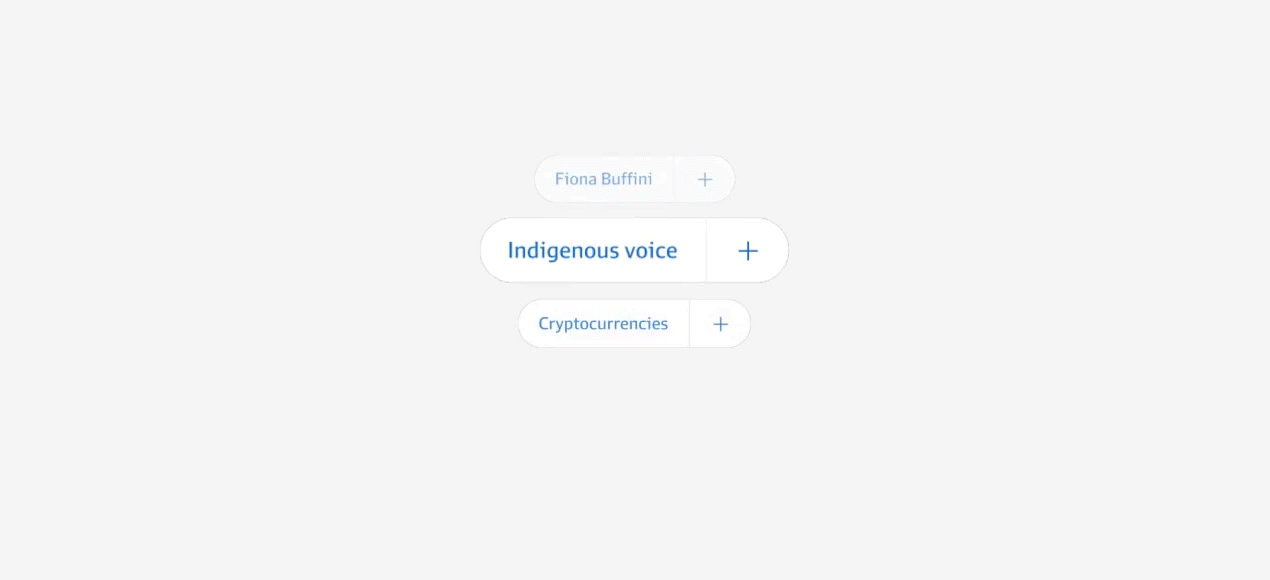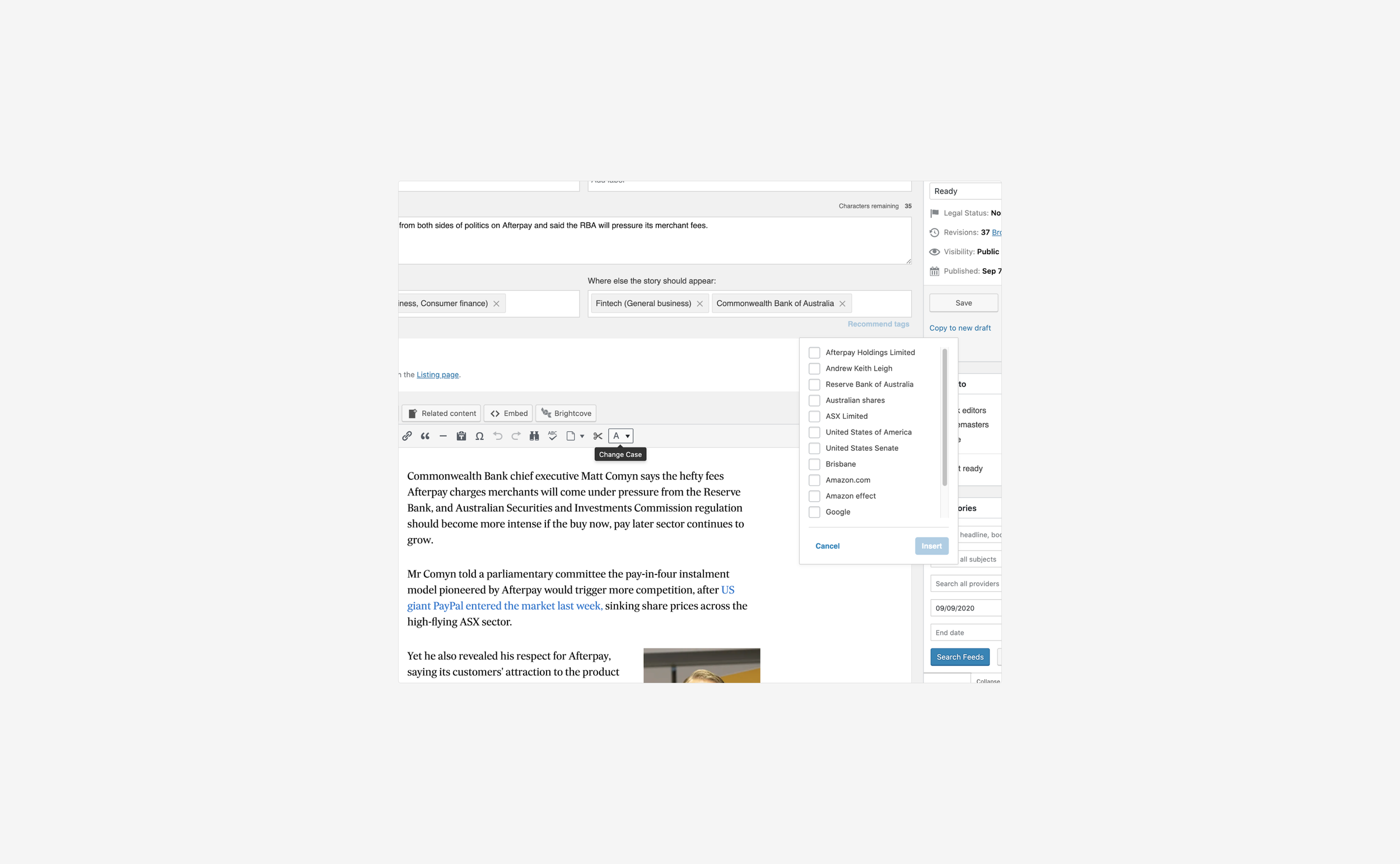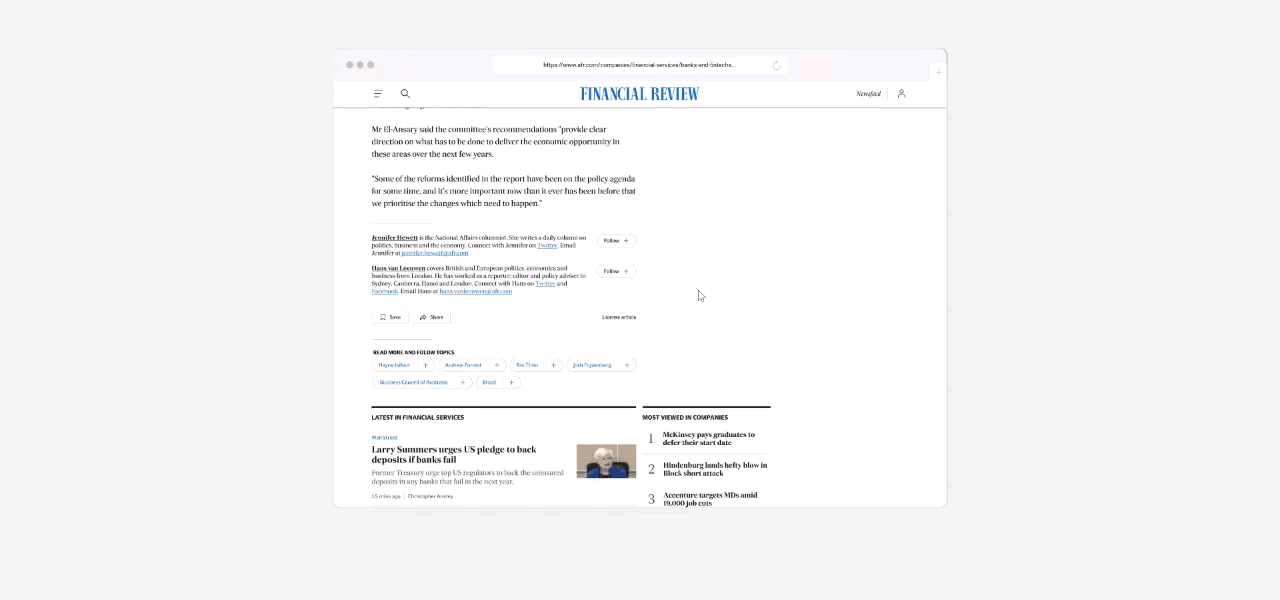Newsfeed
Newsfeed
01
Project Overview
Embed the Financial Review as an indispensable tool in daily life.
One of the reasons people consume business and finance media is to help them make important decisions at work and with their investments. Newsfeed intends to deliver benefit to those who need to know information about specific people, companies or topics when news breaks. It does so by enabling readers to curate a set of entities they want to follow, delivering a feed of relevant stories and company data, and offering an accompaniment of optional notifications.
(Details)
Type
Personalisation Tool
Category
News Publishing
Role
Lead Designer
Company
Nine Entertainment Co.
Brand
Australian Financial Review
02
Challenge
With an archive dating back to 1987, finding referential content can be difficult.
Previously, the best way to search for granular content was deep diving through search and indexes, or sheer luck. To assist readers in finding relevant content, the newsroom began a large project to contextually tag articles, providing a more granular categorisation of content. We asked ourselves:
How can we leverage content tags to enable the Financial Review to become more utilitarian?
“
From a business perspective, not expanding the digital value proposition was seen to be limiting the potential to deliver significant growth — having a great platform to display and browse content, but overall lacking the utility to really embed the Financial Review as an indispensable tool in daily life.
03
Research
/ Value proposition
Mine versus yours.
In the past, both quantitative and qualitative research has shown high audience appeal in features that serve personalised content recommendations based on interests and reading history. To get it right, we needed to get a better understanding of what personalisation meant to our readers as well as their tolerance for it — avoiding the creation of walled gardens, informing, no matter what their granular interests are. Past research has also indicated our audiences discomfort with mixing their personalised view of interests with what the Financial Review deems important — particularly in spaces like the homepage.
In partnership with the research team, we performed qualitative in-depth interviews to better understand users needs and the overall value proposition ‘Newsfeed’ could offer, including what it needed to achieve in order to be successful. We were able to confirm the following hypotheses:
If we give our subscribers a sense of control over their news experience, we can help deepen their knowledge, increasing the return on time and effort they invest which would then increase their perceived value of the Financial Review as a service.
01
Mastery & Control
If we differentiate between features of the overall service that support different information-seeking need states, subscribers can find what they need more efficiently and will see greater value in the service. Focusing on working hand-in-hand with the homepage, rather than replacing it.
02
Mine versus yours
If we provide our subscribers with smart recommendations we can encourage traction and drive adoption of the product. By using the information they provide us, we enable them to discover relevant topics and broaden their horizons
03
Discovery
If we allow our subscribers the ability to curate and filter their interests we can give them a feeling of personalisation. Enabling them to cast a hierarchical perspective over their news experience to get across what matters most, more efficiently.
04
Personalisation
Levels of information seeking
Wireframes
Wireframes







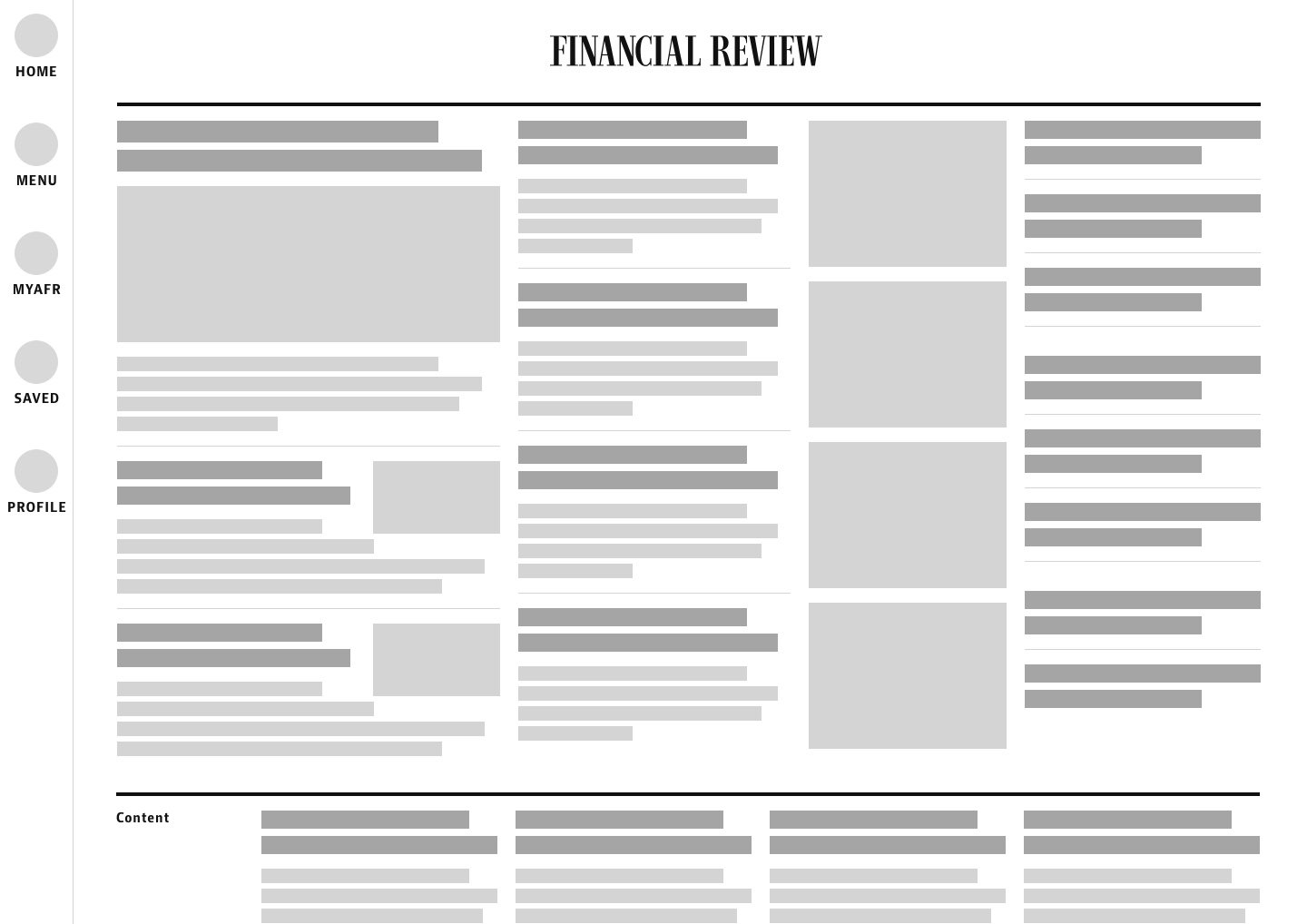
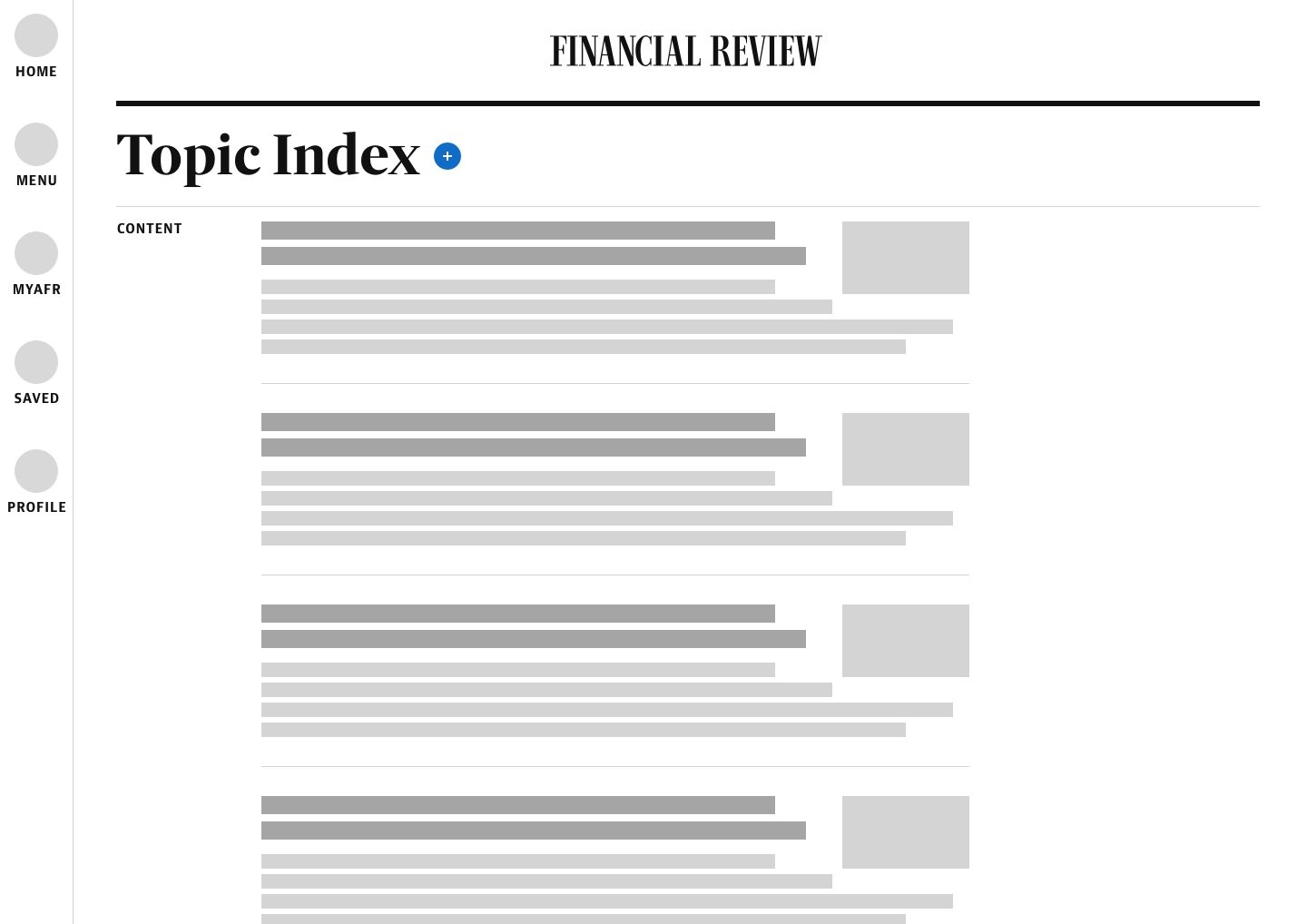










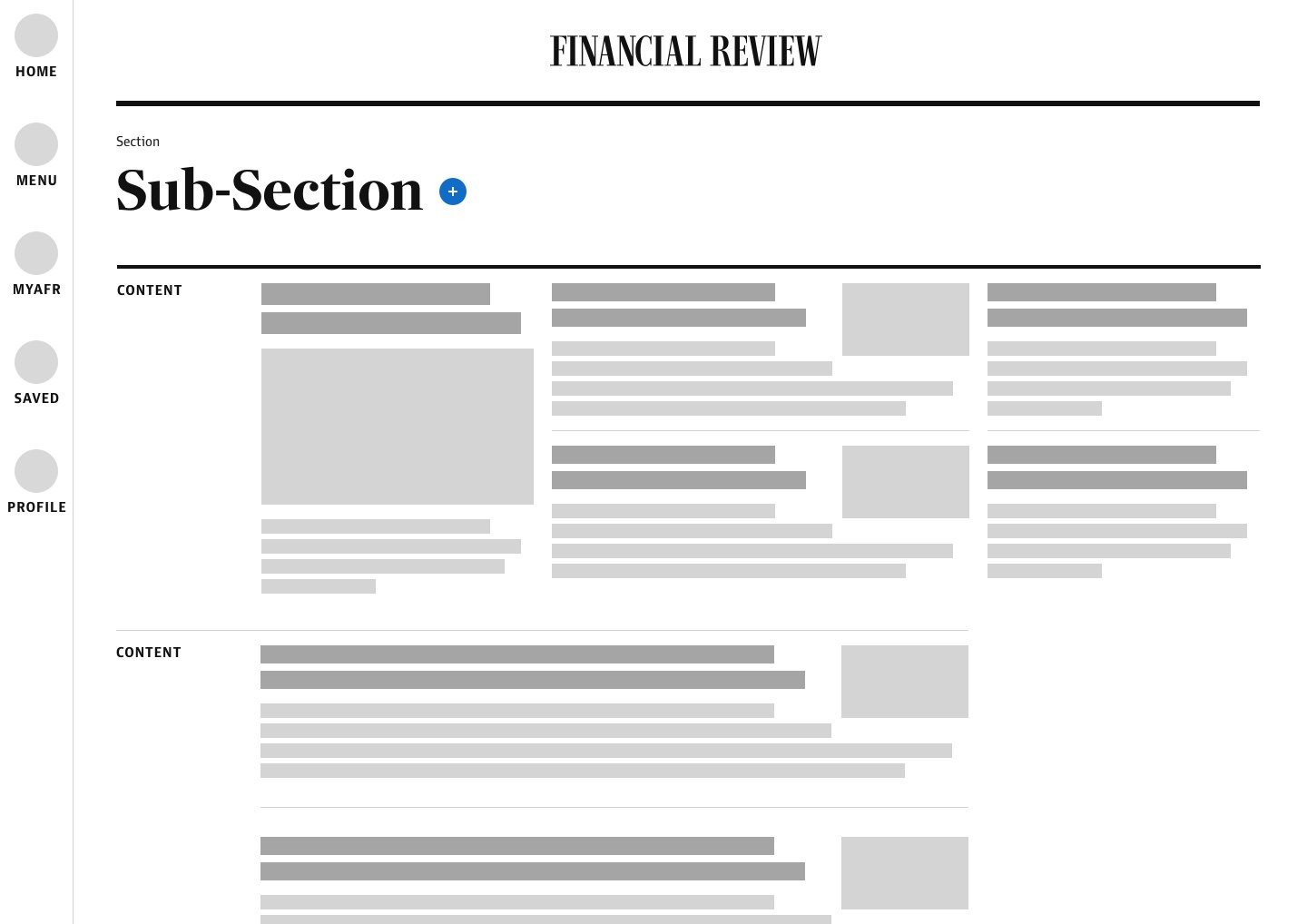
04
Production
So, what is Newsfeed?
Service to product — Newsfeed was born from the opportunity to extend the Financial Review’s core strength as a business news authority, into an indispensable asset for professional advancement. By cultivating an environment of highly engaged readers through Newsfeed, we can further drive subscriber retention and attrition, continuing to be the daily habit of successful people.
Newsfeed is a product aimed at ‘power strivers’. Readers who have a need to stay up to date and are already investing their own personal time and money to progress their professional career and status. Whilst homepage and sections serve to satisfy broad levels of information seeking — Newsfeed satisfies a more granular level of information seeking, working hand in hand with the homepage and sections to give users the ability to stay across the reporting landscape at their own cadence, no matter how time poor they are. It does this by allowing users to declare which of these entities they want to follow, delivering a feed of relevant stories and company data. In addition, knowing readers are busy and often managing multiple platforms, Newsfeed is equipped with automation tools to help create and manage their entities, ensuring their feed is keeping up with their reading trends and needs.
05
Experimentation
Iterate, test, learn, repeat.
With a large investment from the business, alongside the general sentiment of our audience being less forgiving if we weren’t able to deliver on value, experimentation was essential. Through A/B, multivariate and funnel testing using a baseline to meet statistical significance to represent the broader Financial Review audience, we ran a series of experiments to test the effectiveness of Newsfeed — both in terms of achieving its goals, and to refine and optimise the user experience within.
Hypothesis: Automatically adding topics to a user’s list of followed topics based on their reading habits will lead to a greater number of article page views via the newsfeed.
Type: Funnel testing. View Beta segment below for more information.
01
Manual vs Automatic
Hypothesis: A modal is the most effective way of getting users to begin the onboarding process and will not have a net negative impact on general usage of the Financial Review website.
Type: Multivariate testing.
02
CTAs
Hypothesis: Users who go through an ‘onboarding’ tutorial will have higher engagement levels with the Newsfeed than those who do not get presented with an onboarding tutorial.
Type: Funnel testing.
03
Onboarding
Hypothesis: The copy displayed can make a significant difference to the level of engagement a user will have with the Newsfeed drivers and overall product.
Type: A/B testing.
04
Copywriting
06
Experimentation
/ Beta
Maximise success rates by launching intentionally.
Before releasing Newsfeed to all subscribers, a beta test was decided upon to help identify the impact features would have on content engagement and subscriber retention. By only releasing to a limited slice of our subscribers, we were able to buy additional time, using valuable data and insights into user behavior, preferences, and pain points to refine and optimise before releasing to the wider audience — ensuring maximum potential on official launch.
Two experiments were planned to test the following three variations of Newsfeed:
User manually searches and selects what to follow for stories to appear in their Newsfeed.
01
Manual
We recommend what to follow based on a user’s reading history. The user still manually selects what to follow.
02
Manual + Recommendations
We automatically add and remove entities based on a user’s reading history, clearly signaling when new topics have been followed.
03
Automatic
Test on a quantitative scale the demand for a personalised Newsfeed and the impact on content engagement and subscriber retention
01
Experiment 1
Test on a quantitative scale a user’s engagement in an automated Newsfeed versus a manually curated one with recommendations. Observing the choice to switch modes, if made.
Hypothesis: active users of the automatic variant will have higher average article page views per session than active users of the manual mode — but will not have a lower average number of sessions per week.
02
Experiment 2



07
Experimentation
/ Beta — Results
First impressions can be deceiving.
Whilst at a quick glance it can be easy to assume that manually curated Newsfeeds perform better, the statistic to note is click-through rates (CTR) into Newsfeed. For those who chose to have their Newsfeed be automatically curated and maintained, their CTR was significantly higher — with a control rate of 27.48%, manual had an increase of +45% and automatic +127%. So even though users who were in manual mode had, on average, higher page views per session, higher engaged time per session and overall more sessions per week than those in the automated pathway, they (automated users) have a higher potential to eventually increase in all of these statistics. The higher statistics of those who chose to manually curate their feeds could correlate to personalities who are generally more highly engaged and proactive with their management tools.
All subscribers had, on average, lower page views per session and engaged time per session during the experiment period vs before the experiment started, most likely due to the peak in COVID-related traffic in March/April 2020. However the decrease was less pronounced for users who signed up to Newsfeed.
Automatic and manual curation modes cater to the spectrum of subscribers. Given both options attracted a similar level of take-up, we decided to maintain both versions as options for users to choose during onboarding or to switch between at any point during the Newsfeed experience.
Article page views p/s
2.19
2.30
Engaged time
165.96
176.03
Sessions p/w
6.75
9.23
CTR to Newsfeed
62.38%
39.76%
Manual (+ rec)
Automatic
08
“Where are they now?“
With Newsfeed empowering readers to visit more frequently, the Financial Review has seen an 10% increase in article consumption, and growing.
Total active Newsfeed users
27% of subscribers
Automatic
51.6%
Manual
48.4%


